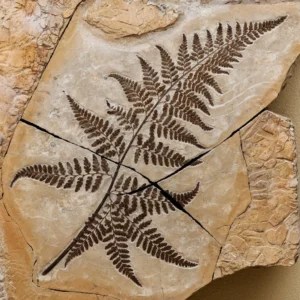Plant fossils are an incredible window into Earth’s prehistoric past, providing invaluable insights into ancient ecosystems, climate change, and the evolution of life on our planet. Whether you’re a seasoned fossil collector or a curious beginner, understanding plant fossils can enhance your appreciation of natural history. In this blog, we’ll explore what plant fossils are, how they form, where they’re found, and why they’re so significant. We’ll also answer some common questions about these remarkable relics from the past.
Table of content – Jump To
What Are Plant Fossils?
How Do Plant Fossils Form?
Where Are Plant Fossils Found?
Why Are Plant Fossils Important?
Common Questions About Plant Fossils
Famous Examples of Plant Fossils
How to Start Collecting Plant Fossils
Conclusion
What Are Plant Fossils?
Plant fossils are the preserved remains, impressions, or traces of ancient plants. These fossils often include leaves, stems, roots, seeds, and even microscopic plant material like pollen or spores. Unlike animal fossils, which often involve bones or shells, plant fossils usually consist of organic material that has been replaced by minerals over time, leaving behind a detailed imprint or cast.
Plant fossils range in age from hundreds of millions of years to a few thousand years, offering snapshots of Earth’s vegetation across vast spans of time.
How Do Plant Fossils Form?
The process of fossilization is rare for plants because they decompose quickly after death. However, under the right conditions, plant material can be preserved. The key steps in plant fossilization include:
- Rapid Burial: Plant material is quickly buried by sediment, protecting it from decay and scavengers.
- Compression: Layers of sediment build up over time, exerting pressure that flattens the plant material.
- Mineral Replacement: Minerals in groundwater seep into the plant material, replacing the organic matter while retaining its structure.
- Preservation: Over millions of years, the sediment hardens into rock, preserving the plant’s form.
Where Are Plant Fossils Found?
Plant fossils are commonly found in sedimentary rock formations like shale, sandstone, and limestone. These rocks are typically formed in environments where sediment accumulates, such as riverbanks, lake beds, and ancient swamps.
Some of the most famous plant fossil sites include:
- The Fossil Forest of Dorset, England: Known for its ancient tree stumps from the Jurassic period.
- Mazon Creek, Illinois, USA: Renowned for its exceptionally well-preserved Carboniferous plant fossils.
- Rhynie Chert, Scotland: A treasure trove of Devonian-era plants and early land ecosystems.
Why Are Plant Fossils Important?
Plant fossils are more than just ancient artifacts; they’re vital for understanding:
- Evolutionary History: They provide evidence of how plants have evolved over millions of years, from simple algae to complex flowering plants.
- Climate Change: Fossilized plants reveal details about past climates, helping scientists study patterns of climate change and its impact on ecosystems.
- Extinct Ecosystems: By studying plant fossils, paleobotanists can reconstruct ancient landscapes and understand how prehistoric ecosystems functioned.

Common Questions About Plant Fossils
1. How Can You Tell a Plant Fossil from a Rock?
Plant fossils often have distinct features like leaf veins, bark patterns, or root structures. These features are usually imprinted or outlined on the rock surface. The texture and shape of the fossilized material can also provide clues.
2. Are Plant Fossils Valuable?
The value of a plant fossil depends on its rarity, preservation quality, and scientific significance. While some plant fossils are highly sought after by collectors, others are more common and primarily valued for their educational importance.
3. Can You Find Plant Fossils in Your Backyard?
In some areas, particularly regions with sedimentary rock formations, you might discover plant fossils. Research your local geology and look for outcrops of shale, sandstone, or coal beds, as these are often rich in plant fossils.
4. What Is the Oldest Plant Fossil Ever Found?
The oldest known plant fossils date back over 1 billion years and are microscopic algae. However, the oldest land plant fossils, like those found in the Rhynie Chert, are around 400 million years old.
5. How Should You Care for Plant Fossils?
Store plant fossils in a stable environment away from direct sunlight, humidity, and extreme temperatures. Use padded containers for fragile specimens and consider labeling them with details about their origin.

Famous Examples of Plant Fossils
- Glossopteris: A seed fern from the Permian period, its fossils were crucial in proving the theory of continental drift.
- Petrified Wood: Fossilized tree trunks, often preserved in stunning detail, are popular among collectors and scientists alike.
- Coal Balls: Fossilized masses of plants found in coal seams, providing insights into Carboniferous swamp ecosystems.
How to Start Collecting Plant Fossils
If you’re interested in collecting plant fossils, follow these tips:
- Research Local Sites: Learn about fossil-rich areas near you.
- Use the Right Tools: A rock hammer, chisel, and safety goggles are essential.
- Respect Regulations: Always obtain permission to collect fossils and adhere to local laws.
- Join a Community: Connect with fossil clubs or online forums to share your finds and learn from others.
Conclusion
Plant fossils are incredible natural artifacts that offer a glimpse into Earth’s distant past. From their formation to their scientific significance, these fossils tell the story of life’s evolution and the changing environment over millions of years. Whether you’re marveling at a delicate leaf imprint or studying the growth rings in petrified wood, plant fossils are a testament to the enduring beauty and resilience of nature.
If you’re fascinated by plant fossils, consider adding them to your collection or visiting a fossil site to see these ancient treasures firsthand. By exploring the world of fossils, you’re not just connecting with the past, you’re gaining a deeper appreciation for the history of life on Earth.






